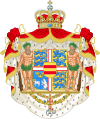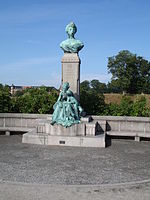- Princess Marie of Orléans (1865–1909)
-
The title of this article contains the character é. Where it is unavailable or not desired, the name may be represented as Princess Marie of Orleans.
Princess Marie Amélie Françoise Hélène d'Orléans (13 January 1865, Ham, near Richmond, Surrey – 4 December 1909, Copenhagen) was a French princess by birth and a Danish princess by marriage. She was politically active.
Contents
Biography
Background
Marie was the eldest child of Robert, duke of Chartres (the second son of Ferdinand Philippe, Duke of Orléans and Duchess Helena of Mecklenburg-Schwerin) and his wife, Princess Françoise d'Orléans. Françoise was the daughter of François d'Orléans, prince de Joinville and Princess Francisca of Brazil.
Born during the reign in France of her family's rival, Napoléon III, she grew up in England, were her family had moved in 1848. She moved to France with her family after the fall of Napoleon in 1871. She defined herself as “une bourgeoise”.
Nuptials
She married Prince Valdemar of Denmark, the youngest son of Christian IX of Denmark, after the consent of the pope, on 20 October 1885 in a civil ceremony in Paris and again in a religious ceremony in the Château d'Eu two days later. She remained a Roman Catholic, he a Lutheran. They adhered to the dynastic arrangement usually stipulated in the marriage contract in such circumstances: sons were to be raised in the faith of their father, daughters in the denomination of their mother.
The couple took up residence in the castle of Bernstorff in Copenhagen, in which Valdemar had been born. Since 1883, Valdemar had lived there with his nephew and ward, Prince George of Greece, a younger son of Valdemar's elder brother, Vilhelm, who had become king of the Hellenes in 1863. The king had taken the boy to Denmark to enlist him in the Danish navy, and consigned him to the care of his brother, Valdemar, who was an admiral in the Danish fleet.
Feeling abandoned by his father on this occasion, George would later describe to his fiancée, Princess Marie Bonaparte, the profound attachment he developed for his uncle from that day forward.[1]
It was into this household and relationship that Marie came to live. In 1907, when George brought his bride to Bernstorff for the first family visit, Marie d'Orléans was at pains to explain to Marie Bonaparte the intimacy which united uncle and nephew, so deep that at the end of each of George's several yearly visits to Bernstorff, he would weep, Valdemar would take sick, and the women learned the patience not to intrude upon their husbands' private moments.[2]
On this and subsequent visits, the Bonaparte princess found herself a great admirer of the Orléans princess, concluding that she was the only member of her husband's large family in Denmark and Greece endowed with brains, pluck, or character. Marie, in addition to her duties as mother and royal hostess, painted. During the first of these visits, Valdemar and Marie Bonaparte found themselves engaging in the kind of passionate intimacies she had looked forward to with her husband who, however, only seemed to enjoy them vicariously, sitting or lying beside his wife and uncle. On a later visit, George's wife carried on a passionate flirtation with Prince Aage, Valdemar's eldest son. In neither case does it appear that Marie objected, or felt obliged to give the matter any attention.[3]
George criticized Marie to his wife, alleging that she was having an affair with his uncle's stablemaster. He also contended that she drank too much alcohol, and could not conceal the effects. But Marie Bonaparte found no fault with Marie d'Orléans, rather, she admired her forbearance and independence under circumstances which caused her bewilderment and estrangement from her own husband.[4]
Marriage
She was described as impulsive, witty and energetic and eased things up at the stiff Danish court. She never fully learned to speak Danish. The marriage was friendly. She gave her children a free upbringing, and her artistic taste and Bohemian habits dominated her household. In 1886, Valdemar declined the throne of Bulgaria with her consent. She was informal, believed in equality and was not snobby, and performed her ceremonial duties in an unconventional manner, and once wrote: "I believe that a person, regardless of her position, should be herself" (1896). She was an independent character with firm opinions, and showed this both privately and publicly. She liked both to ride and to drive and was known for her elegance. She was the official protector of the fire brigade and let herself be photographed in a fire brigade uniform, which was caricatured, and as a support to her spouse's career as a marine, she had an anchor tattooed on her upper arm. She once said regarding the complaints of her unconventional manners: "Let them complain, I am just as happy nevertheless".
She had asked the permission of the court to leave the house withouth a lady-in-waiting, and she had mainly spent her time with artists. She painted and photographed and was a student of Otto Bache and Frants Henningsen. She participated in the exhibitions on Charlottenborg 1889, 1901 and 1902 and was a member of the Danish Arts Academy.
She refused to obey the expectation on royal women to stay away from politics. She belonged to the political left and participated in convincing the king to agree to the reforms of 1901, which led to an appointment of a Venstre government,[5] and the de facto introduction of parliamentarism. In 1902, she rejected the idea to leave the Danish West Indies to USA. She also saw to the interests of France: she was credited by the French press to have influenced the French-Russian alliance in 1894 and the peace in the French-German Colonial conflict of Morocco in 1905. She assisted her friend, the founder of East Asiatic Company, H.N. Andersen, with contacts in his affairs in Thailand. She was a popular person in Denmark.
Marie's husband and three sons were in India en route to Siam when they received word that she had died at Bernstorff.[6]
Issue
The couple had five children:
- Prince Aage of Denmark (1887–1940), married Mathilda Calvi dei Conti di Bergolo in 1914 and had one son
- Prince Axel of Denmark (1888–1964), married Margaretha of Sweden in 1919 and had two sons
- Prince Erik of Denmark (1890–1950), married Lois Frances Booth in Ottawa, Canada 1924, divorced 1937, and had a son and a daughter.
- Prince Viggo of Denmark (1893–1970), created Count of Rosenborg, married Eleonora Green, and had no children
- Princess Margrethe of Denmark (1895–1992), married Prince René of Bourbon-Parma. Her daughter Anne is titular Queen of Romania.
Legacy
Princess Marie is conmemorated with a monument at [[Langelinie[[, near St. Alben's English Church in Copenhagen. It was installed in 1912 in features a bust created by Carl Martin-Hansen.
Ancestry
Ancestors of Princess Marie of Orléans (1865–1909) 16. Louis Philippe II, Duke of Orléans 8. Louis-Philippe I of France 17. Louise Marie Adélaïde de Bourbon 4. Ferdinand Philippe, Duke of Orléans 18. Ferdinand I of the Two Sicilies 9. Maria Amalia of the Two Sicilies 19. Maria Carolina of Austria 2. Robert d'Orléans 20. Frederick Francis I, Grand Duke of Mecklenburg 10. Frederick Louis, Hereditary Grand Duke of Mecklenburg-Schwerin 21. Princess Louise of Saxe-Gotha-Altenburg 5. Hélène of Meklenburg-Schwerin 22. Charles Augustus, Grand Duke of Saxe-Weimar-Eisenach 11. Karoline of Saxe-Weimar-Eisenach 23. Louise of Hesse-Darmstadt 1. Princess Marie of Orléans 24. Louis Philippe II, Duke of Orléans 12. Louis-Philippe I of France 25. Louise Marie Adélaïde de Bourbon 6. François d'Orléans 26. Ferdinand I of the Two Sicilies 13. Maria Amalia of the Two Sicilies 27. Maria Carolina of Austria 3. Françoise of Orléans 28. John VI of Portugal 14. Pedro I of Brazil 29. Charlotte of Spain 7. Francisca of Brazil 30. Francis II, Holy Roman Emperor 15. Maria Leopoldina of Austria 31. Maria Theresa of Naples and Sicily Notes
- ^ Bertin, Celia (1982). "A False Happiness". Marie Bonaparte: A Life. New York: Harcourt Brace Jovanovich. pp. 85–86. ISBN 0-15-157252-6. "From that day, from that moment on, I loved him and I have never had any other friend but him...You will love him too, when you meet him."
- ^ Bertin, Celia (1982). "A False Happiness". Marie Bonaparte: A Life. New York: Harcourt Brace Jovanovich. pp. 96–98. ISBN 0-15-157252-6.
- ^ Bertin, Celia (1982). "A False Happiness". Marie Bonaparte: A Life. New York: Harcourt Brace Jovanovich. pp. 96–97, 101. ISBN 0-15-157252-6.
- ^ Bertin, Celia (1982). "A False Happiness". Marie Bonaparte: A Life. New York: Harcourt Brace Jovanovich. pp. 97. ISBN 0-15-157252-6.
- ^ http://www.kvinfo.dk/side/597/bio/1409/origin/170/
- ^ Bertin, Celia (1982). Marie Bonaparte: A Life. New York: Harcourt Brace Jovanovich. ISBN 0-15-157252-6.
References
External links
Princesses of Orléans The first generation are the children of Gaston, Duke of Orléans, son of Henry IV; the second is from Philippe, Duke of Orléans, son of Louis XIII; 1st Generation Anne Marie Louise, Duchess of Montpensier^ · Marguerite Louise, Grand Duchess of Tuscany^ · Élisabeth Marguerite, Duchess of Guise^ · Françoise Madeleine, Duchess of Savoy^ · Princess Marie Anne^
2nd Generation Marie Louise, Queen of Spain^ · Anne Marie, Queen of Sardinia^ · Élisabeth Charlotte, Duchess of Lorraine^
3rd Generation Louise Élisabeth, Duchess of Berry^ · Louise Adélaïde, Abbess of Chelles^ · Charlotte Aglaé, Duchess of Modena^ · Louise Élisabeth, Queen of Spain^ · Philippine Élisabeth, Mademoiselle de Beaujolais^ · Louise Diane, Princess of Conti^
4th Generation Princess Louise Marie^
5th Generation Mademoiselle d'Orléans^ · Bathilde, Princess of Condé^
6th Generation Françoise, Mademoiselle de Chartres^ · Adélaïde, Princess of Orléans
7th Generation Louise, Queen of the Belgians · Marie, Duchess of Württemberg · Princess Françoise · Clémentine, Princess of Kohary
8th Generation Marguerite Adelaide, Princess Czartoryska · Princess Blanche · Françoise, Duchess of Chartres · Marie Isabelle, Countess of Paris · Princess Amalia · Princess Cristina · Princess Maria de la Regla · Mercedes, Queen of Spain
9th Generation Amélie, Queen of Portugal · Hélène, Duchess of Aosta · Isabelle, Duchess of Guise · Louise, Princess Carlos of the Two Sicilies · Marie, Princess Valdemar of Denmark · Margherite, Duchess of Magenta · Louise, Princess Alfons of Bavaria
10th Generation Isabelle, Princess Pierre Murat · Françoise, Princess Cristopher of Greece and Denmark · Anne, Duchess of Aosta · Marie Louise, Princess Philip of the Two Sicilies · Princess Sophie · Genieviève, Marchioness of Chaponay
11th Generation Isabelle, Countess of Schönborn-Buchheim · Hélène, Countess Evrard of Limburg-Stirum · Anne, Duchess of Calabria · Diane, Duchess of Württemberg · Claude, Duchess of Aosta · Chantal, Baroness François Xavier de Sambucy de Sorgue · Gerarda, Marchioness of Marchelina · Beatriz, Countess Tomasso Farini
12th Generation Isabelle, Princess Gundakar of Liechtenstein · Princess Blanche · Princess Clothilde, Mrs. Edouard Crépy · Princess Adélaïde, Mrs. Pierre-Louis Dailly · Diane, Viscountess Alexis of Noailles · Princess Pilar, Mrs. Nicholas Henderson-Stewart · Princess Eulalia
13th Generation Princess Thérèse Isabelle · Princess Louise Marie · Princesse Hélène · Princess Isabelle
^never styled Princess of Orléans Danish princesses by marriage 1st generation Princess Louise of Sweden and Norway · Princess Marie of Orléans
2nd generation Duchess Alexandrine of Mecklenburg-Schwerin · Princess Maud of the United Kingdom · Princess Helena Adelaide of Schleswig-Holstein-Sonderburg-Glücksburg · Princess Sophia of Prussia* · Princess Marie Bonaparte* · Grand Duchess Elena Vladimirovna of Russia* · Princess Alice of Battenberg* · Princess Françoise of Orléans* · Princess Margaretha of Sweden3rd generation 4th generation 5th generation Mary Donaldson^ · Alexandra Manley^** · Marie Cavallier^ · Marie-Chantal Miller^* · Tatiana Blatnik^**also a princess of Greece by marriage
**title lost due to divorce and subsequent remarriage
^did not have a royal or noble title by birthCategories:- Danish princesses
- Princesses of France (Orléans)
- House of Glücksburg (Denmark)
- House of Orléans
- 1865 births
- 1909 deaths
Wikimedia Foundation. 2010.


